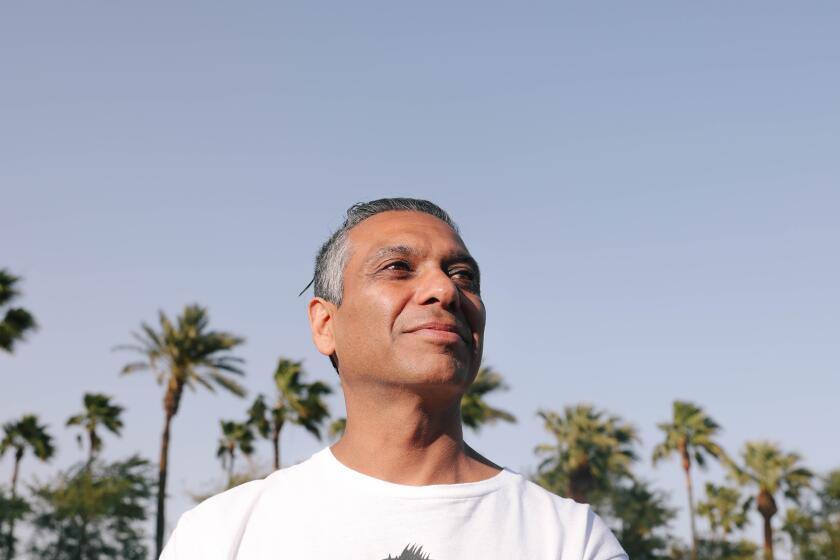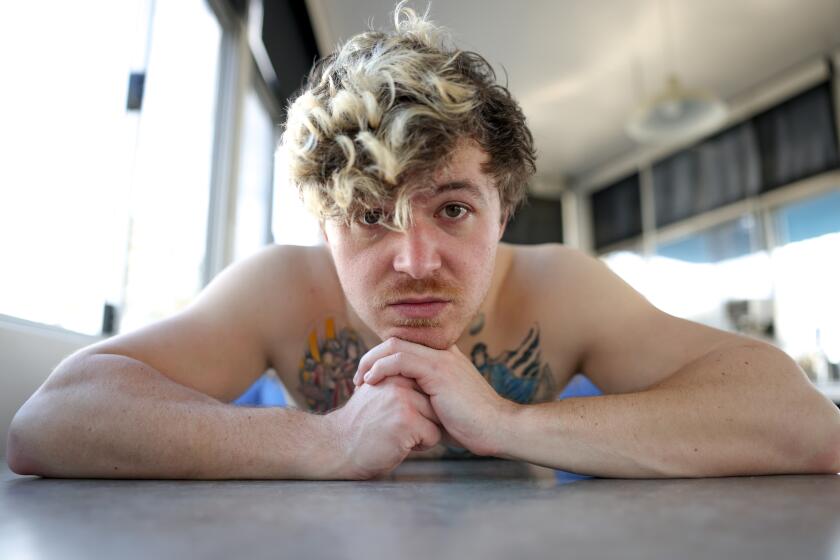Coachella and Stagecoach sound guy Dave Rat reveals the secrets to keeping the music crystal clear
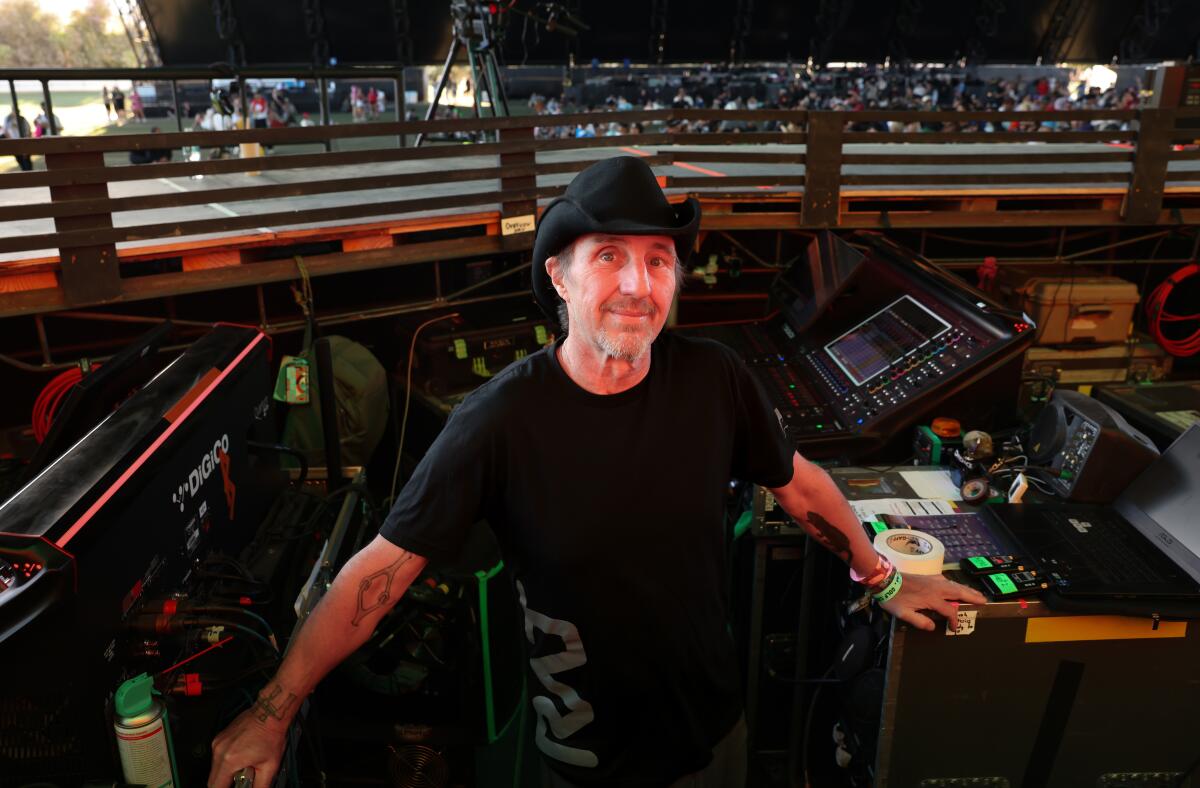
- Share via
On a hill overlooking the early evening landscape of the Coachella Valley Music and Arts Festival in Indio, Dave Rat is listening closely.
Rat is the festival’s longtime sound engineer and system designer, whose company Rat Sound has been with the festival since its beginnings, virtually without interruption. And in front of him is the new, nearly 100-foot-tall Sahara “tent,” the expanded metal structure that hosts some of the festival’s most acclaimed dance music acts.
It now stands beside the hill originally constructed as a circular mound for Kanye West’s gospel-themed “Sunday Service” at the 2019 festival, and is part of Coachella’s ever-expanding footprint. Onstage is the DJ Anyma, with a big screen filled with digital effects and animation to accompany his urgent beats and thundering distortion. Rat likes what he hears.
“This is like the best spot at the festival. It’s gorgeous,” says Rat, who was born David Levine in 1962. He’s wearing a black jacket with his company’s rat-shaped insignia, the wide brim of his black cowboy hat folded tightly against his head. “Every year there’s new challenges. I learn new stuff every year. We get to do things that have never been done, and on a big scale.”
Somewhere amid the scaffolding beneath the stage are 30-inch,10,000-watt subwoofer speakers designed and built by Rat Sound. “It’ll blur your vision,” says Rat. “This is like the heartbeat of the stage really.”
There are piles of other subwoofers all over the Sahara space, including several based on a prototype Rat first designed for the Los Angeles punk-rock band Black Flag in 1986. In those days, singer Henry Rollins began calling the young soundman “Ratman,” while others called him “Rat Boy.” The name stuck.
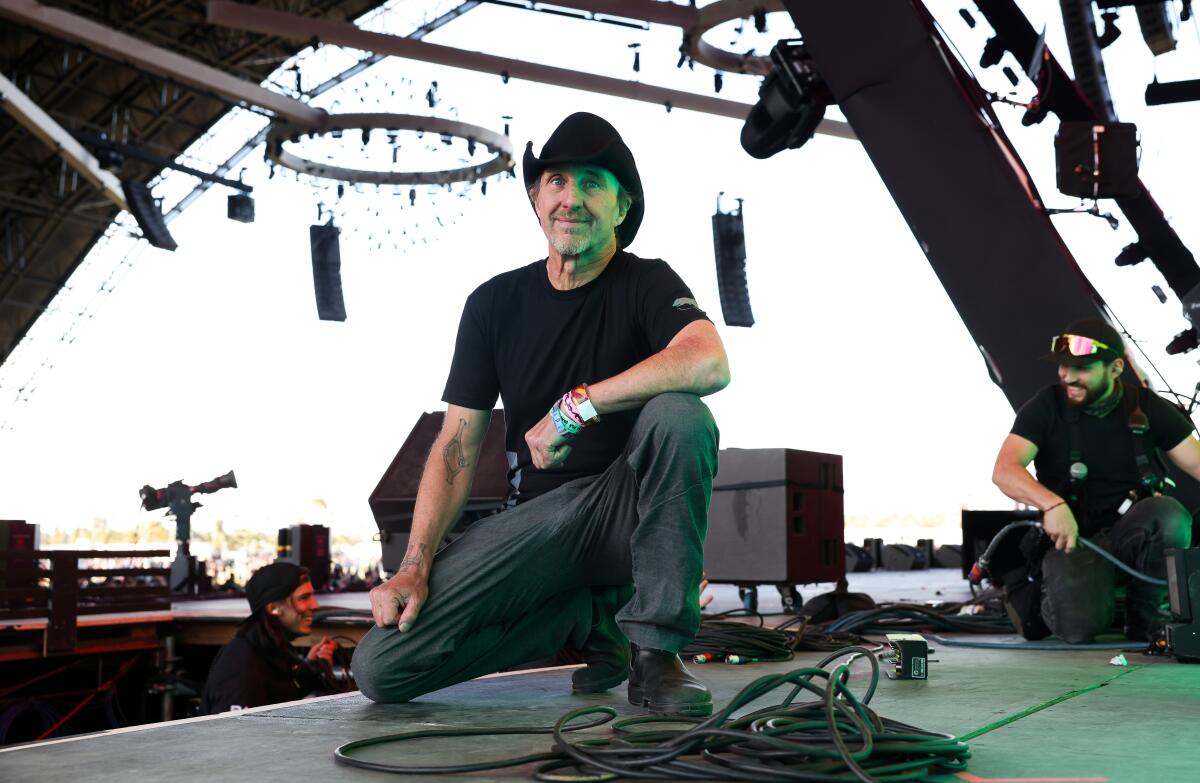
Behind the Sahara console the whole weekend is soundman Radek Lesa, flown in from the Czech Republic every year for his expertise. Tall and bearded, Lesa first encountered Rat when the American sound engineer was passing through Europe during one of his many tours with the Red Hot Chili Peppers. Lesa now presides over some of the largest crowds of the weekend, and what he calls “this insane, beautiful stage. It’s one of the greatest setups I have ever used.”
Lesa is part of Rat’s expanded team, adding to about 25 full-time Rat Sound staffers who deliver world-class sound to Coachella. “We’ve got people from all over the country and world that are the best or really darn good at what they do,” says Rat. “We bring all this family together and get them on our team and deploy. And that’s how we’re able to be competitive with these much larger companies.”
Soon, Rat wanders out of the Sahara toward the new Quasar stage, where DJs perform elongated sets, and pauses on the lawn where the intensity emanating from one stage fades and music from the other stage begins to swell. Sound bleed from one stage to another is a common concern at music festivals, so dialing in that balance is a central mission for him.
In 2009, he notes, virtually the entire festival volume was dialed down to make room for an elegantly understated performance by singer-songwriter Leonard Cohen on the Outdoor stage.
“I’m very acoustic oriented and I always have been,” Rat says. “Sound to me — I can visualize it. I can visualize a bunch of subwoofers as independent energy sources, and whether they’re synchronized or unsynchronized determines which way the energy will go.”
By the time Radiohead and the Pixies closed the main stage on opening day of the 2004 festival, the sound at Coachella was often spectacular. During those performances, the music was notably crisp, landing on the grassy landscape like thunderbolts. Now every year, adjustments to the sound are made to counter the weather, time of day, the size of the crowds, anything.
“The environmental factors are a beautiful and complex part of the equation,” Rat says. “Nothing is fixed. It’s constantly moving like the ocean.”
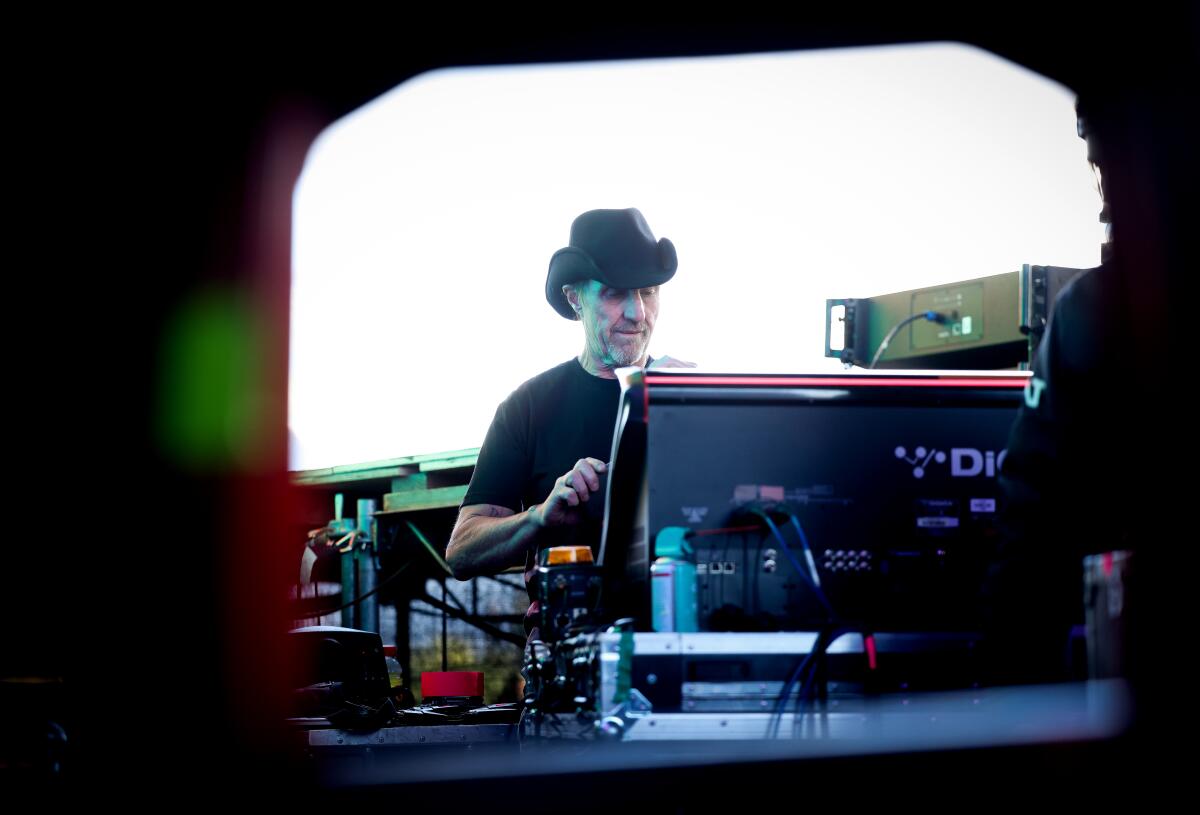
Owing something to his roots in the first wave of SoCal punk rock, he’s willing to break rules to get there. Despite his success as the lead sound contractor at Coachella, his methods are sometimes the subject of heated discussion among sound nerds. A topic on Reddit called “I don’t understand Dave Rat” that began two years ago launched a passionate scroll of debate.
Rat even posted a friendly YouTube video responding to all that.
“There’s a lot of, ‘This is the way it’s done.’ And if you threaten that — they get really upset,” Rat says with a smile of the larger concert sound community. “It’s like almost asking them about their religion or something.”
There have been many career highlights along the way, including one that reached back to his adolescence listening to Black Sabbath, Led Zeppelin and Pink Floyd. When former Pink Floyd member Roger Waters headlined the third night of Coachella 2008, he performed the band’s entire 1973 album “Dark Side of the Moon.” Waters also had taggers scrawl words of geopolitical protest on the show’s inflatable pig, and a graffiti artist painted the soundman’s Rat insignia on one of its feet.
“It was just kind of full circle,” Rat says of watching one of his classic rock heroes, now part of his own professional history. “It was just a moment of like, ‘How did we get here?’”
His most stressful nights at the festival, he says, were the Coachella years when the Red Hot Chili Peppers were among the headliners — since Rat was responsible then for both the overall festival sound and as the longtime engineer for the band. In 2013, the band played through a blinding sandstorm.
“This brown dirt was just blowing straight into my face and grit in my eyes,” he recalls. “It was like nature came down and just thwarted my adventure there.”
“Dave in L.A. underground music is a … legend,” says Chili Peppers bassist Flea. “He’s just a unique human being with a wild energy. He’s a tough dude. You want him in your corner when you’re on the road. In the world of do-it-yourself, punk rock, underground music, he is the epitome of greatness because he did it all and figured it out himself. Dave Rat’s an amazing guy.”
Early on, Rat imagined a career in the studio making records, but found the tedium and repetition in a confined recording space far less attractive than the challenge of live music. “I was bored out of my mind. I kept falling asleep,” he recalls. “They kept doing the same thing over and over again.”
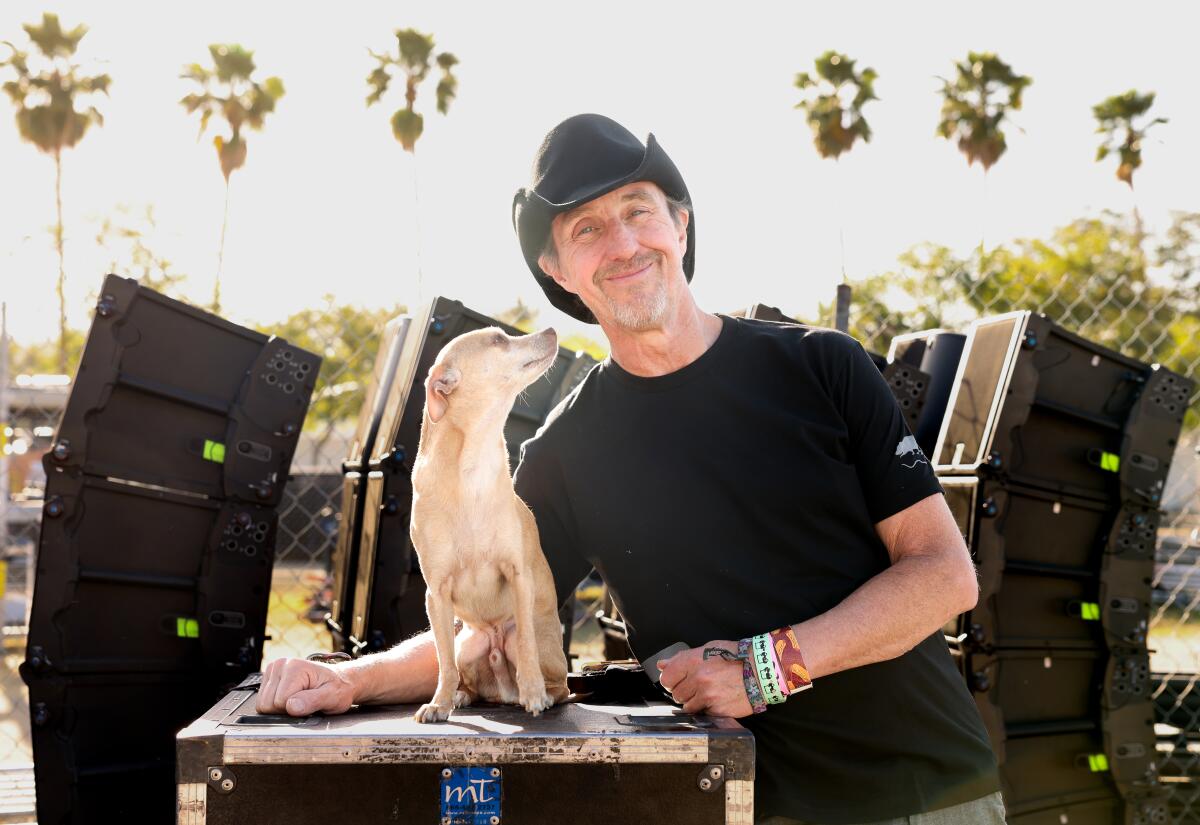
From that point onward, Rat has been focused almost entirely on live sound production, starting his Reliable Audio Technology firm when still a teenager. By the mid-1980s, his young company began working smaller shows for Goldenvoice Productions, which years later created Coachella.
“He’s one of the best guys we’ve ever known,” says Goldenvoice founder Gary Tovar. “We knew the importance of Dave Rat — good reliable sound and good personality. He kept adding [gear] and kept up with the times. We were loyal to him all the way.”
Rat grew up in Hermosa Beach in the same neighborhood as the notorious punk rock landmark the Church, a former house of worship that by the late 1970s was being used as a rehearsal space (and sometime crash pad) by Black Flag. He met the band there and began recording their shows on cassette tapes, his two mics sometimes taped to the ceiling of the Hong Kong Café, then traded them later for tickets to the next gig.
He soon began building his own speakers and sound gear, and rented it out. Rat Sound gear was specially constructed to survive the sometimes punishing environment of a combative punk rock show. Using skills learned during a brief stint working in environmental testing at Hughes Aircraft, he created sound equipment for the worst-case scenario.
“I knew how to build things not to break,” Rat recalls. “We’d use heavy duty steel grills and giant connectors and bolted all the microphones to the stands so they couldn’t steal them. This was a challenge rather than a bummer. And we also loved the punk rock.”
Not every mainstream sound company was prepared for that kind of challenge, which left an opening for Rat’s young firm. “You’re renting a performance dune buggy, not a limo,” he adds of his gear’s durability. “And the [bigger] sound companies, they’re renting limos.”
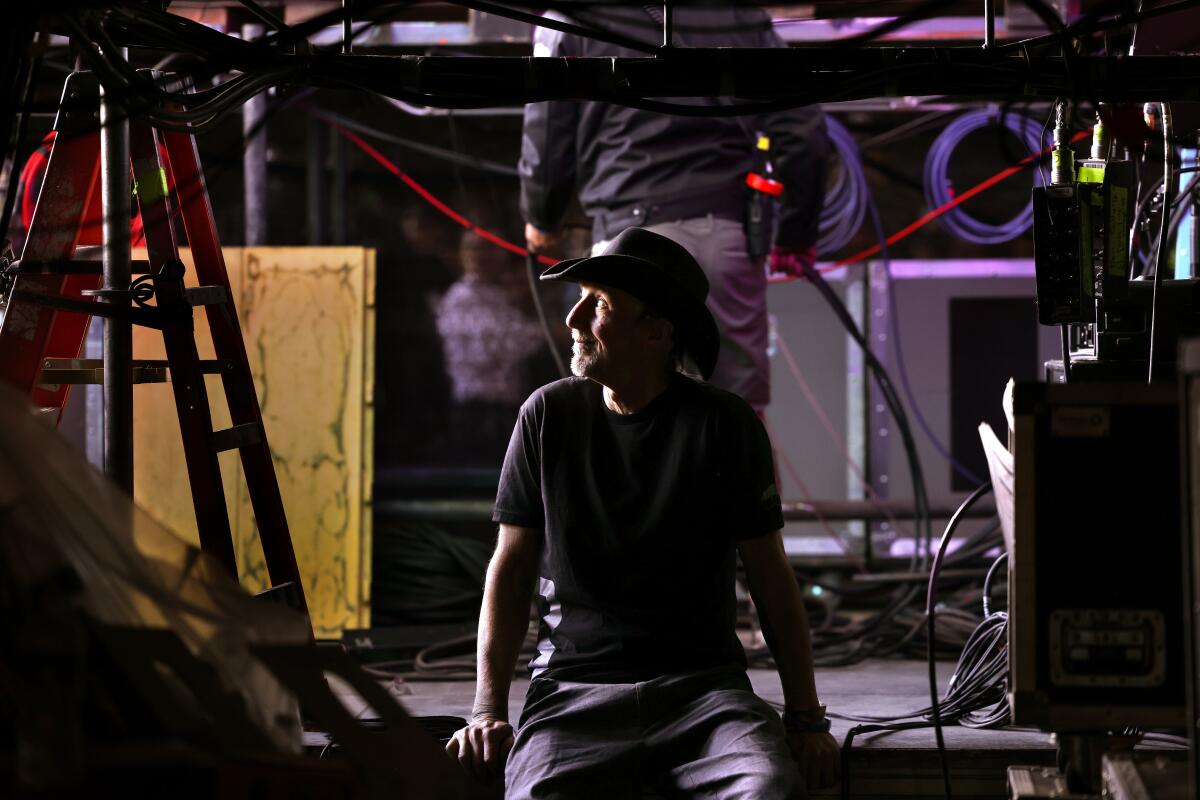
Many nights were an adventure. Rat was doing sound at the club Safari Sam’s in Huntington Beach in the mid-1980s when the Minutemen were onstage. Singer-guitarist D. Boon was jumping behind the mic when he crashed through the floor mid-song. Boon kept singing.
In 1985, Rat was recruited by Black Flag to provide full sound on the road, as part of a crew to enable the band to be self-sufficient on tour. Rat ended up working three tours with Black Flag, which then broke up in 1986.
These were low-budget van tours, with band and crew very often crashing in the homes of fans in towns across the country. Rat often found a closet to sleep in.
“It was that kind of us against the world mentality. I was full militant about it,” says Rat, who devised ways to get around frequent interruptions by police, such as finding power sources he could tap into independent of the venue. “The cops would come in and shut off the power of the building. All the lights would go out, but the sound kept going.”
He was hired to provide sound for Danzig, Soundgarden and Sonic Youth in the late ‘80s and early ‘90s. Starting in 1990, Rat served as lead sound engineer for the Red Hot Chili Peppers for 27 years. He’s been with Pearl Jam since the early ‘90s and after this year’s Coachella and Stagecoach fests in Indio were behind him, he planned to fly up to Seattle to help with band rehearsals.
Goldenvoice remains his longest and most consistent professional association, especially since Coachella’s founding in 1999 by Paul Tollett and the late Rick Van Santen. He remembers first hearing about the new festival in the desert after working on a one-off concert in 1993 at the same location with Pearl Jam. Rat ran into Tollett at a Walmart.
“He said, ‘We’re going to start this festival in the desert. We’re going to call it Coachella.’ I was like, ‘Oh, that’s not that great of a name,’” Rat remembers with a laugh. “And he’s like, ‘No, no, it’s catchy.’ Oh, OK.”
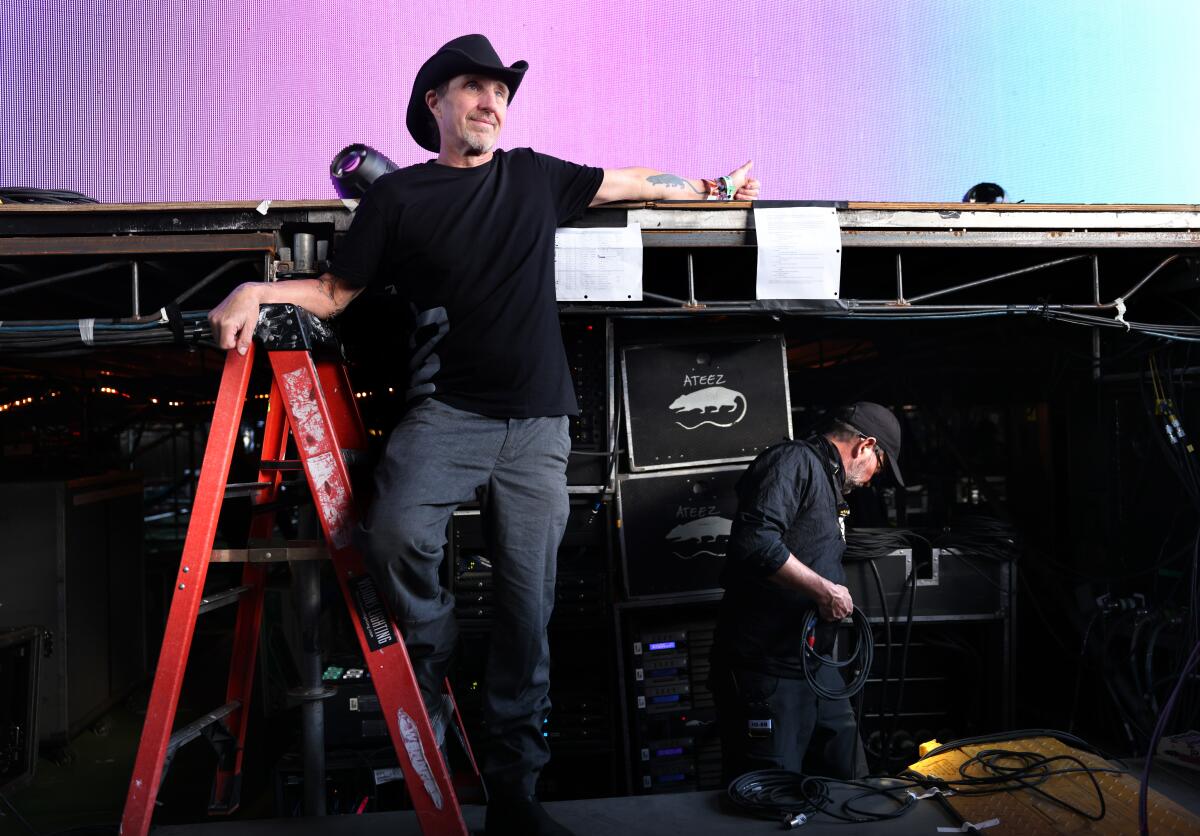
“Paul is like Pearl Jam — we’ve been there since the beginning. We will jump on a grenade for him, and we hopefully will do better than anyone else can do because we care,” Rat adds. “It’s not just another account to us. This goes back 40 years for me.”
Most of his work is done before the Coachella gates open up. “If everything goes well, I don’t have much to do here,” he says. “I can kind of wander around.” So he was able to make a point of watching No Doubt’s entire set, reuniting him with a band he’s known since its earliest days in Orange County.
Near the end of the first weekend, Rat is at the main stage again, making his way beside the catwalks toward the sound monitors, as J Balvin is mid-performance, surrounded by aliens and sci-fi décor. Will Smith has just popped up onstage to sing along, rapping in his “Men in Black” suit and sunglasses.
When Rat reaches the “front of house” production area facing the stage, dozens of technicians are at work, and Rat makes a sweeping gesture to all the monitors and equipment around him. “Mission control,” he says with a grin, then watches the rest of Balvin’s performance, taking in Coachella’s sound, rich and crisp as always. His work is done.
More to Read
The biggest entertainment stories
Get our big stories about Hollywood, film, television, music, arts, culture and more right in your inbox as soon as they publish.
You may occasionally receive promotional content from the Los Angeles Times.
